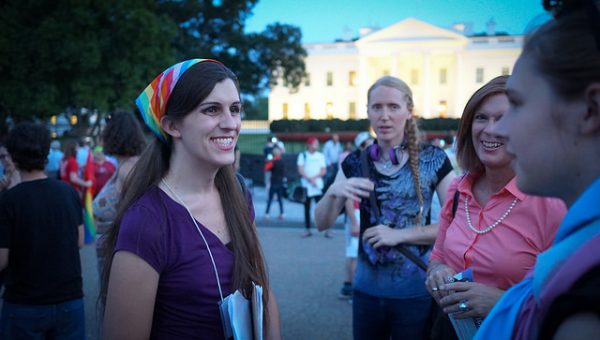
Originally posted November 28, 2017.
American attitudes towards transgender and gender nonconforming persons might be changing. Earlier this month, voters elected six transgender officials to public office in the United States, and poll data from earlier this year suggests the majority of Americans oppose transgender bathroom restrictions and support LGBT nondiscrimination laws. Yet, data on attitudes toward transgender folks is extremely limited, and with the Trump administration’s assault on transgender protections in the military and workplace, the future for the trans community is unclear. Despite this uncertainty, a close examination of the social science research on past shifts in attitudes towards same-sex relationships can provide us insight for what the future may hold for the LGBTQ community in the coming decades.
Attitudes about homosexuality vary globally. While gay marriage is currently legal in more than twenty countries, many nations still criminalize same-sex relationships. Differences in attitudes about homosexuality between countries can be explained by a variety of factors, including religious context, the strength of democratic institutions, and the country’s level of economic development.
- Amy Adamczyk. 2017. Cross-National Public Opinion about Homoseuxality: Examining Attitudes Across the Globe. Oakland, CA: University of California Press.
In the United States, the late 1980s witnessed little acceptance of same-sex marriage, except for small groups of people who tended to be highly educated, from urban backgrounds, or non-religious. By 2010, support for same-sex marriage increased dramatically, though older Americans, Republicans, and evangelicals were significantly more likely to remain opposed to same-sex marriage. Such a dramatic shift in a relatively short period of time indicates changing attitudes rather than generational differences.
- Dawn Michelle Baunach. 2012. “Changing Same-Sex Marriage Attitudes in America from 1988 Through 2010.” Public Opinion Quarterly 76(2): 364-378.
- Kathy Hull. 2014. “Same-Sex, Different Attitudes.” The Society Pages, White Paper.
Americans have also become more inclusive in their definition of family. In 2003, nearly half of Americans emphasized heterosexual marriage in their definition of family, while only about a quarter adopted a definition that included same-sex couples. By 2010, nearly one third of Americans ascribed to a more inclusive understanding of family structures. Evidence suggests that these shifts in attitudes were partially the result of broader societal shifts in the United States, including increased educational attainment and changing cultural norms.
- Brian Powell, Catherine Bolzendahl, Claudia Geist, and Lala Carr Steelman. 2010. Counted Out: Same-Sex Relations and America’s Definition of Family. New York: Russell Sage Foundation.
- Jeni Loftus. 2001. “America’s Liberalization in Attitudes Toward Homosexuality, 1973 to 1998.” American Sociological Review, 762-782.
Despite this progress for same-sex couples, many challenges remain. Members of the LGBTQ community still experience prejudice, discrimination, and hate crimes — especially for trans women of color. Even with support for formal rights for same-sex couples from the majority of Americans, the same people are often uncomfortable with informal privileges, like showing physical affection in public. Past debates within LGBTQ communities about the importance of fighting for marriage rights indicates that the future for the LGBTQ folks in the United States is uncertain. While the future can seem harrowing, the recent victories in the United States and Australia for same-sex couples and transgender individuals would have been unheard of only a few decades ago, which offers a beacon of hope to LGBTQ communities.
- Long Doan, Annalise Loehr, and Lisa R. Miller. 2014. “Formal Rights and Informal Privileges for Same-Sex Couples: Evidence from a National Survey Experiment.” American Sociological Review 79(6): 1172-1195.
- Mary Bernstein and Verta Taylor, eds. 2013. The Marrying Kind? Debating Same-Sex Marriage within the Lesbian and Gay Movement. Minneapolis: University of Minnesota Press.
—
Want to read more?
Check out these posts on TSP:
- Violence and Discrimination against Transgender People
- Attitudes toward Gay and Lesbian People Have Grown More Accepting around the World. Why? And What Obstacles Remain?
Review historical trends in public opinion on gay and lesbian rights (Gallup)
Check out research showing that bisexual adults are less likely to be “out” (Pew Research Center)

Comments